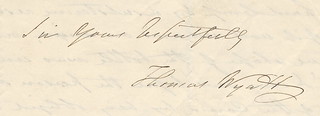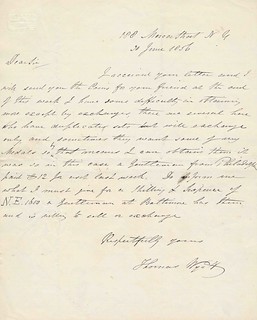
PREV ARTICLE
NEXT ARTICLE
FULL ISSUE
PREV FULL ISSUE
COLONIAL COIN FORGER THOMAS WYATT LETTERS OFFERED
David Fanning sent this announcement regarding some fascinating material to be offered this week at the Kolbe & Fanning table at the ANA convention this week.
-Editor
TO BE OFFERED AT ANA CONVENTION BY KOLBE & FANNING:
Kolbe & Fanning Numismatic Booksellers are proud to announce that they will be displaying for sale at this week’s American Numismatic Association World’s Fair of Money an exceptionally important group of six handwritten letters by the notorious forger Thomas Wyatt.
The group of letters begins with a 20 June 1856 missive asking the recipient to “inform me what I must give for a shilling & sixpence of N.E. 1650 a gentleman at Baltimore has them and is willing to sell or exchange.” A letter dated 5 July mentions that Wyatt’s unnamed source “has got the coin of the ‘Good Samaritan coined in Massachusetts,’” and asks about it. This famous fantasy piece is discussed repeatedly in the following letters. A remarkable letter dated 14 July states that “As soon as I receive the Good Samaritan piece I will enclose it to you with their price and you can do as you please about keeping it.” It also claims that “a widow lady of Chambersburg has 6 of the pine tree money pennies in a collection belonging to her late husband a Gentleman assures me he can obtain them for me she wishes to sell the collection I have requested to know particulars.” The letter mentions Jeremiah Colburn, the Boston numismatist who would publically condemn the pieces as counterfeit by August. By late July, accusations are beginning to be made and Wyatt is feeling the heat. In a letter dated 28 July, he states, “As to the Pine Tree Money being Counterfeit I believe no such thing.” Referring to the imaginary “Chelsea Hoard” from which his trove of these pieces allegedly derived, Wyatt writes, “I saw & examined the bottle &c myself with many others and they all pronounced them genuine, many of them were stuck together in a hard lump by a substance resembling pitch some of it now remains on mine, and the antique shape of the bottle was unlike any thing I ever saw before.” He further claims that the N.E. coinage he offered came from the collection of Robert Gilmore. On 7 August, Wyatt writes, “I have not received the Good Samaritan till this morning’s mail and I enclose it for your approval.” He asks for $7 for the coin, claiming that he will only be breaking even by such a transaction. He notes that “Mr Colburn requested as soon as I received it I would send it to him,” but Wyatt demurs. He alludes to further treasures to come from the collection at Chambersburg, including “2 Lord Baltimore shillings as good as new.” By the 12th of August, Wyatt is in defensive mode, writing, “Whatever you may be disposed to think, I have acted justly to you in every point and that man does not live that can accuse me of the reverse without slander & falsehood but there is a clique here that what they cannot obtain by fair means they will by defamation and trickery.” He adds that “you are quite mistaken about the coins being spurious metal, we tried them here in Nitric Acid and they were pronounced good silver.”

All six letters are clearly signed by Wyatt and are in near fine condition. This extraordinary archive of material pertaining to one of the more audacious and famous numismatic frauds of the nineteenth century will be the highlight of Kolbe & Fanning’s 2016 ANA Convention offerings. Come and see them at Booths 263 and 362 or write David Fanning at df@numislit.com for more information.
For background, here are links to some content available on the Newman Numismatic Portal.
-Editor
From Pete Smith, American Numismatic Biographies:
Thomas Wyatt
To read the complete article, see:
From The Secret of the Good Samaritan Shilling: The Good Samaritan shilling has been a subject of mystery and active controversy for over two hundred years. The two varieties of this major rarity are attributed by some to the first mint in the American colonies and by others rejected as spurious fabrications, leaving a numismatic issue of primary importance unresolved. The facts from which a proper conclusion may be drawn have never been known, so that unsupported opinions and theories have predominated in all prior writing on the subject. Numismatic literature, including modern catalogues, have left the matter open for further research by admitting the existing uncertainty.
To read the complete monograph, see:

Wayne Homren, Editor The Numismatic Bibliomania Society is a non-profit organization promoting numismatic literature. See our web site at coinbooks.org. To submit items for publication in The E-Sylum, write to the Editor at this address: whomren@gmail.com To subscribe go to: https://my.binhost.com/lists/listinfo/esylum All Rights Reserved. NBS Home Page Contact the NBS webmaster 
|
